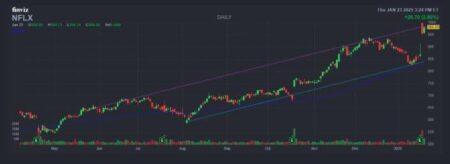Johnson & Johnson (NYSE: JNJ) recently reported its Q4 results, with revenues and earnings exceeding the street estimates. The company reported revenue of $22.5 billion and adjusted earnings of $2.04 per share, compared to the consensus estimates of $22.4 billion and $2.02, respectively. The company continued to benefit from increasing sales of Darzalex. The company’s outlook for 2025 was also above expectations. However, JNJ stock fell 2% post the results announcement.
JNJ stock, with -4% returns since the beginning of 2024, has underperformed the S&P 500 index, up 28%. One of the company’s top-selling drugs is now facing biosimilar competition, weighing on its stock price growth lately. If you want upside with a smoother ride than an individual stock, consider the High-Quality portfolio, which has outperformed the S&P, and clocked >91% returns since inception.
Johnson & Johnson’s revenue of $22.5 billion in Q4 was up 5.3% y-o-y. The company reported a 4.4% rise in Innovative Medicine (pharmaceuticals business) and a 6.7% growth for its MedTech (medical devices business) segment. The pharmaceuticals sales growth was led by a continued uptick for Darzalex, up 21% y-o-y. The comparatively newer drugs – Erleada and Spravato continued to see double-digit gains. However, Stelara saw its revenue fall 15% y-o-y to $2.3 billion in Q4. Stelara is expected to see a meaningful decline in the coming years, given the biosimilar competition. MedTech sales growth was led by the cardiovascular business, up 24% y-o-y to $2.1 billion, led by the impact of the Shockwave Medical acquisition in May last year.
Johnson & Johnson’s gross margin improved by 180 bps y-o-y to 68.3% in Q4. It reported adjusted earnings of $2.04 per share, compared to $2.29 per share in the prior-year quarter. The bottom-line figure for Q4’24 includes a $0.22 per share charge toward acquired IPR&D charges related to the V-Wave acquisition.
Looking forward, Johnson & Johnson reported the 2025 sales outlook of $91.5 billion and adjusted earnings of $10.85 per share at the mid-point of the guided range. This fares better than the consensus estimates of $91.0 billion and $10.56 per share, respectively.
What does this mean for JNJ stock?
Although Johnson & Johnson posted an upbeat Q4, its stock hasn’t seen any upside post the results announcement. Even if we look at a slightly longer period, the performance of JNJ stock with respect to the broader markets over the last four-year period has been quite volatile. In contrast, the Trefis High Quality Portfolio, with a collection of 30 stocks, is less volatile. And it has comfortably outperformed the S&P 500 over the last four-year period. Why is that? As a group, HQ Portfolio stocks provided better returns with less risk versus the benchmark index; less of a roller-coaster ride, as evident in HQ Portfolio performance metrics.
Given the current uncertain macroeconomic environment around rate cuts and changes in the White House, could JNJ underperform the S&P over the next 12 months — or will it see a strong jump? While we will soon update our model for JNJ to reflect the latest results, from a valuation perspective, we think JNJ stock has some room for growth. At its current levels of $145, JNJ stock is trading at 13x forward expected earnings of $10.85 per share, at the mid-point of the company’s provided range. The 13x figure is lower than the stock’s average P/E ratio of 17x over the last five years.
While JNJ stock looks like it has some room for growth, it is helpful to see how Johnson & Johnson’s Peers fare on metrics that matter. You will find other valuable comparisons for companies across industries at Peer Comparisons.
Invest with Trefis Market Beating Portfolios
See all Trefis Price Estimates
Read the full article here
















